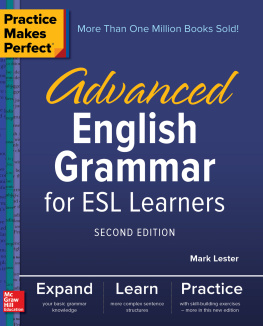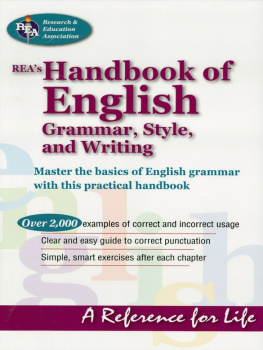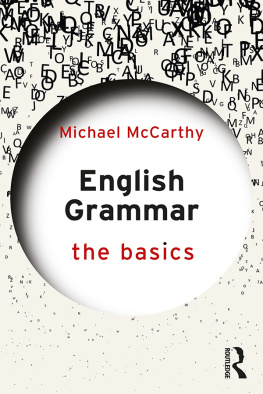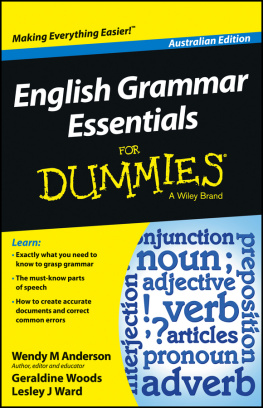
Copyright 2013 by Mark Lester and Larry Beason. All rights reserved. Except as permitted under the United States Copyright Act of 1976, no part of this publication may be reproduced or distributed in any form or by any means, or stored in a database or retrieval system, without the prior written permission of the publisher.
ISBN: 978-0-07-179991-1
MHID: 0-07-179991-5
The material in this eBook also appears in the print version of this title: ISBN: 978-0-07-179990-4, MHID: 0-07-179990-7.
All trademarks are trademarks of their respective owners. Rather than put a trademark symbol after every occurrence of a trademarked name, we use names in an editorial fashion only, and to the benefit of the trademark owner, with no intention of infringement of the trademark. Where such designations appear in this book, they have been printed with initial caps.
McGraw-Hill eBooks are available at special quantity discounts to use as premiums and sales promotions, or for use in corporate training programs. To contact a representative please e-mail us at bulksales@mcgraw-hill.com.
Interior design by Nick Panos
TERMS OF USE
This is a copyrighted work and The McGraw-Hill Companies, Inc. (McGraw-Hill) and its licensors reserve all rights in and to the work. Use of this work is subject to these terms. Except as permitted under the Copyright Act of 1976 and the right to store and retrieve one copy of the work, you may not decompile, disassemble, reverse engineer, reproduce, modify, create derivative works based upon, transmit, distribute, disseminate, sell, publish or sublicense the work or any part of it without McGraw-Hills prior consent. You may use the work for your own noncommercial and personal use; any other use of the work is strictly prohibited. Your right to use the work may be terminated if you fail to comply with these terms.
THE WORK IS PROVIDED AS IS. McGRAW-HILL AND ITS LICENSORS MAKE NO GUARANTEES OR WARRANTIES AS TO THE ACCURACY, ADEQUACY OR COMPLETENESS OF OR RESULTS TO BE OBTAINED FROM USING THE WORK, INCLUDING ANY INFORMATION THAT CAN BE ACCESSED THROUGH THE WORK VIA HYPERLINK OR OTHERWISE, AND EXPRESSLY DISCLAIM ANY WARRANTY, EXPRESS OR IMPLIED, INCLUDING BUT NOT LIMITED TO IMPLIED WARRANTIES OF MERCHANTABILITY OR FITNESS FOR A PARTICULAR PURPOSE. McGraw-Hill and its licensors do not warrant or guarantee that the functions contained in the work will meet your requirements or that its operation will be uninterrupted or error free. Neither McGraw-Hill nor its licensors shall be liable to you or anyone else for any inaccuracy, error or omission, regardless of cause, in the work or for any damages resulting therefrom. McGraw-Hill has no responsibility for the content of any information accessed through the work. Under no circumstances shall McGraw-Hill and/or its licensors be liable for any indirect, incidental, special, punitive, consequential or similar damages that result from the use of or inability to use the work, even if any of them has been advised of the possibility of such damages. This limitation of liability shall apply to any claim or cause whatsoever whether such claim or cause arises in contract, tort or otherwise.
Contents
Acknowledgments
We wish to thank several people who have helped with the writing and production of this book. In terms of publishing and production, we thank Publisher Christopher Brown and Acquisitions Editor Holly McGuire. In terms of the writing, we thank our students, academic colleagues, and people in the business sector who have helped us learn more about what constitutes a serious language error and effective ways for avoiding these problems.
Introduction
You should say what you mean, the March Hare went on.
I do, Alice hastily replied; at leastat least I mean what I saythats the same thing, you know.
Not the same thing a bit! said the Hatter. You might just as well say that I see what I eat is the same thing as I eat what I see!
Alice in Wonderland
The March Hare sounds as though he might have been an English teacher! Whatever his profession, he is clearly aware that precision in ones language choices can be a serious matter.
Such precision is especially important in written communication. Writing, unlike conversation, allows you to refine your language before sharing it, and readers are well aware you have this prep time for writing. When we show our writing to others, there is an expectation of correctness and precision far beyond the expectations of day-to-day conversations. Mistakes that are routinely accepted in casual conversation are glaringly apparent in writingor in formal speaking situations.
English teachers and March Hares are not the only ones who expect our language choices to be made carefully and correctly. Indeed, many businesspeople are far more demanding than English teachers when it comes to following grammar rules and preferences. Errors and poor decisions in regard to language can annoy readers of all sorts, can confuse people about what you are trying to say, and can lead your audience to question your credibility or professionalism.
Thus, we offer this book to help people improve their ability to follow the rules, conventions, and preferences associated with formal English. This book is intended for various readers and needs. You might feel your skills in these areas need drastic improvement, or you might just need to brush up on a few matters.
Grammar books are commonplace. What makes this one different? Following are seven features that set this book apart:
Separating grammar and usage: Part I focuses on the grammatical terminology used to describe language. Part II goes a step further by covering the rules and conventionsthe prescriptions for proper language, or what you should and should not do in formal communication. Rather than conflate these two issues (description versus prescription), this book separates them so readers can pay attention to the parts that matter most to them.
A nontechnical approach: You do not have to be a grammarian or linguist to use this book. Part I covers the technical aspects of grammar, but we assume our readers do not necessarily have a background in this area. More importantly, Part II does not rely on Part I or on previous knowledge of formal grammar.
Accessible, bottom-line information: Part II in particular offers bottom-line definitions, hints, and rules that summarize the least you need to know about grammar and usage.
More than just the bottom line: Most reference books on grammar stop with the bottom-line rules and with maybe an example or two. The problem is that almost every grammar rule is not self-explanatory. If it were, you would not need a book on grammar at this point in your life. Unlike most reference books on grammar, ours gives a thorough explanation so that you can better understand the rules, exceptions, and methods for correcting an error. Our goal is for you to know how to avoid problems so you will not need this or any other grammar book later. Thus, we provide enough information so you can truly understand and learn.
A focus on the most important aspects of grammar and usage: To avoid overwhelming our readers, this book focuses on what matters the most. Neither Part I nor Part II covers every aspect of formal English. Instead, Part I deals with the grammatical terminology and information that are most useful and common. Part II deals with the most serious or most frequent errors in formal English.







